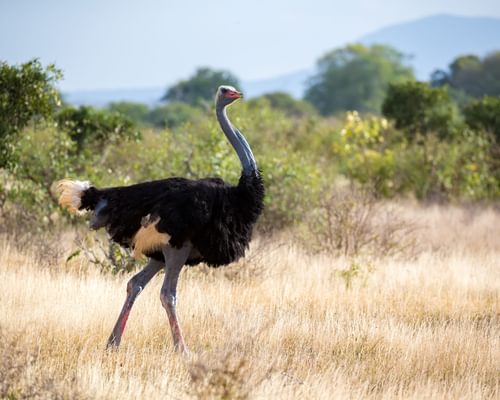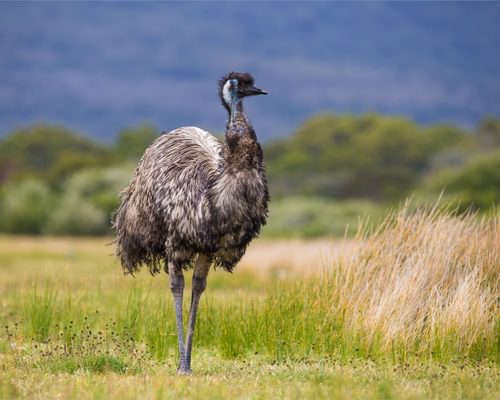Common Ostrich
Least ConcernStruthio camelus
Visual Identification
Appearance
The Common Ostrich is a striking bird. Males boast black body feathers contrasted by white wing and tail plumes. Their long, bare necks and legs are pinkish-grey, and their heads are relatively small with large, expressive eyes.
Females are slightly smaller and have duller, brown-grey plumage. Juveniles resemble females but have streaked necks and legs. Both sexes have two-toed feet, which is unique among birds.
Size
Length
210cm to 275cm
Wingspan
200cm to 250cm
Weight
63kg to 145kg
Special Accolades
Fastest Running Bird
Fastest running speed of any bird
Record: 70 km/h (43.5 mph)
Largest Bird
Largest and heaviest living bird
Record: Up to 2.75 m (9 ft) tall and weighing up to 156 kg (344 lb)
Habitat and Distribution
Habitats
Woodland
Garden
Wetland
Coastal
Urban
Farmland
Grassland
Desert
Tundra
Rainforest
Mountain
Savanna
Distribution
Common Ostriches inhabit open, arid, and semi-arid landscapes across sub-Saharan Africa. They thrive in grasslands, savannas, and the fringes of deserts, where their excellent vision and speed are advantageous.
While primarily found in East and Southern Africa, including countries like Kenya, Tanzania, and South Africa, small populations also exist in West Africa. They are absent from densely forested areas and true deserts.
Elevation Range
Up to 3,000 meters
Climate zones
Tropical, Subtropical, Arid
Distribution Map
This map gives you a rough idea of where you might spot a Common Ostrich. The coloured areas show countries where these birds have been seen.
A few things to keep in mind:
- Birds might not be everywhere in the coloured areas, for example, they may be present around the coast of that country
- Where birds live can change with seasons and available food
- This map is quite simple - it doesn't show exact locations
We're working on making our maps even better! Soon, we hope to show you:
- More detailed maps for bigger countries, including state and region
- How birds move around during different seasons
Distribution by Region
Behaviour and Ecology
Bird Attributes
This feature is in beta. We'd love your feedback to improve it!
Share your thoughtsBird Attributes Explained
Our bird attributes system rates various aspects of a bird's capabilities on a scale of 0-100, based on data from field observations, scientific studies, and expert knowledge.
Attribute Categories:
- Agility: Manoeuvrability, speed, and grace in flight or movement.
- Strength: Physical power, often correlating with size and hunting abilities.
- Adaptability: Ability to thrive in various environments or changing conditions.
- Aggressiveness: Territorial behaviour and assertiveness, particularly during breeding seasons.
- Endurance: Stamina, often seen in migration patterns or foraging behaviours.
Understanding the Ratings:
- 0-20: Very Low
- 21-40: Low
- 41-60: Average
- 61-80: High
- 81-100: Very High
Remember, these attributes are relative to other bird species and don't necessarily indicate superiority.
Hover over the icon next to each attribute for more information.
Tap the icon next to each attribute for more information.
Agility
Reflects the bird's manoeuvrability, speed, and grace in flight or movement.
The Common Ostrich exhibits remarkable agility for its size, capable of sprinting at speeds up to 70 km/h (43 mph). Its long, powerful legs and two-toed feet enable swift changes in direction, crucial for evading predators in open habitats.
Strength
Indicates the bird's physical power, often correlating with size and hunting abilities.
As the world's largest bird, the ostrich possesses formidable strength. Its muscular legs can deliver powerful kicks, capable of seriously injuring potential predators. The bird's size and strength allow it to carry up to 145 kg, showcasing its robust build.
Adaptability
Represents the bird's ability to thrive in various environments or changing conditions.
Ostriches demonstrate good adaptability, thriving in various open habitats from grasslands to semi-arid regions. Their ability to survive without water for several days and their omnivorous diet contribute to their adaptability. However, they are limited to specific habitat types, reducing their overall adaptability score.
Aggressiveness
Measures the bird's territorial behaviour and assertiveness, particularly during breeding seasons.
While generally not aggressive, ostriches can display significant aggression when threatened or during breeding season. Males, in particular, may fiercely defend their territory and mates. Their powerful kicks make them formidable opponents, but they typically prefer flight over fight when given the option.
Endurance
Reflects the bird's stamina, often seen in migration patterns or foraging behaviours.
Ostriches possess impressive endurance, adapted for life in harsh African environments. Their ability to maintain high speeds over long distances, survive without water for extended periods, and thrive in hot climates demonstrates remarkable stamina. However, they are not migratory, which slightly limits their endurance rating.
Diet
Behaviour
Ostriches are highly social, often forming large flocks outside the breeding season. They are known for their impressive speed, using their powerful legs to outrun predators.
When threatened, they may also lie flat on the ground to blend in with their surroundings, contrary to the myth of burying their heads in sand.
Vocalisation
Nesting & Breeding
Ostriches breed during the dry season. Males perform elaborate courtship displays to attract females. A dominant male may mate with several females, forming a harem.
Nests are simple scrapes in the ground, often in communal nesting areas. The dominant female lays 7-10 cream-coloured eggs, with subordinate females adding their eggs to the clutch, totalling up to 60 eggs per nest.
Incubation lasts about 42 days, with the male primarily incubating at night and the female during the day. Chicks are precocial, able to run within hours of hatching, and remain with their parents for up to a year.
Lifespan
years
The Common Ostrich typically lives for 30 to 40 years.
Like all birds, lifespan can be affected by factors including predation, habitat quality, disease, and access to food sources.
Conservation and Status
Global Conservation Status
Population Data
Global Population Estimate
Unknown
Global Population Trend
Trend data may be uncertain or fluctuating
Birdwatching Tips
- Look for ostriches in open grasslands and savannas
- Observe from a safe distance, as they can be aggressive if approached too closely
- Watch for their distinctive gait and tall profile on the horizon
- Visit wildlife reserves in East or Southern Africa for the best viewing opportunities
Additional Information
Quick Facts
Other names:
Ostrich
Family:
StruthionidaePredators
Did You Know?
- An ostrich's eye is bigger than its brain.
- They can survive without water for several days, obtaining moisture from their food.
- Ostrich eggs are the largest of any living bird, weighing up to 1.5 kg.
Was this bird profile helpful?
Your feedback helps us improve our content
Thanks for your feedback!
Your input helps us improve our content.
Community Experience
Community Ratings
No ratings yet - be the first to rate this bird!
Latest Community Reviews
No reviews yet
Sign in to be the first to review
Community Reviews
Create Your Free Account Welcome Back!
Join our community to rate birds and share your experiences. Creating an account is completely free and only takes a minute. Sign in to your account to rate birds and share your experiences with our community.
Your information is secure and will never be shared.
By creating an account, you agree to our Privacy Policy.
Similar Birds
References
- 1
website: BirdLife International. 2018. Struthio camelus. The IUCN Red List of Threatened Species 2018: e.T45020636A132189458.
View source

